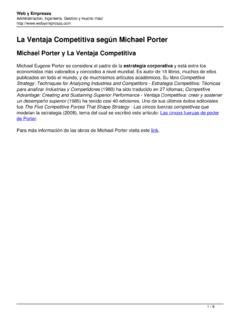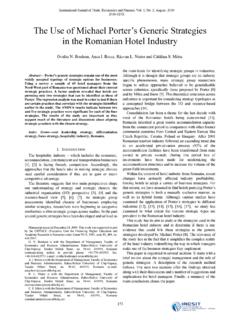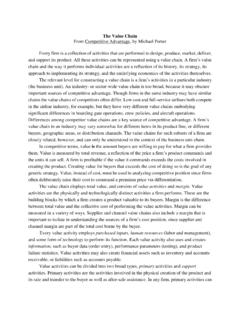Transcription of The Competitive Advantage ofCorporate Philanthropy
1 The Competitive Advantageof Corporate Philanthropyby michael and Mark r0212dHBR Case Studyro212aLicense to OverkillPaul F. NunesManaging Yourselfro212bHow to Stay Stuck in the Wrong CareerHerminia IbarraBig Picturero212cWhat s a Business For?Charles HandyThe Competitive Advantage ro212dof Corporate PhilanthropyMichael E. Porter and Mark R. KramerHoles at the Top:Why CEO Firings Backfirero212eMargarethe WiersemaThe Young and the Cluelessro212fKerry A. Bunker, Kathy E. Kram, and Sharon TingExpensing Options Solves Nothingro212gWilliam A. SahlmanBest Practicero212hCrisis Communication: Lessons from 9/11 Paul ArgentiThe Entrepreneurro212jWhy Entrepreneurs Don t ScaleJohn HammDecember 2002by michael E. Porter and Mark R. Kramerorporate philanthropyis in decline. Char-itable contributions by companies fell real dollars last year, and over the last 15 years,corporate giving as a percentage of profits has dropped by 50%.
2 The reasons are not hard to understand. Ex-ecutives increasingly see them-selves in a no-win situation,caughtbetween critics demanding everhigher levels of corporate socialresponsibility and investors ap-plying relentless pressure to max-imize short-term profits. Givingmore does not satisfy the critics the more companies donate, themore is expected of them. And executives find it hard, ifnot impossible,to justify charitable expenditures in termsof bottom-line dilemma has led many companies to seek to bemore strategic in their Philanthropy . But what passes for strategic Philanthropy today is almost never truly stra-tegic, and often it isn t even particularly effective as phil-anthropy. Increasingly, Philanthropy is used as a form ofpublic relations or advertising, promoting a company simage or brand through cause-related marketing or otherhigh-profile it still represents onlya small proportion of overall corporate charitable expen-ditures, corporate spending on cause-related mar-keting jumped from $125 million in 1990 to an estimated$828 million in 2002.
3 Arts sponsorships are growing,too they accounted for an addi-tional $589 million in 2001. Whilethese campaigns do provide much-needed support to worthy causes,they are intended as much to in-crease company visibility and im-prove employee morale as to cre-ate social impact. Tobacco giantPhilip Morris, for example, spent$75 million on its charitable contributions in 1999 andthen launched a $100 million advertising campaign topublicize them. Not surprisingly, there are genuinedoubts about whether such approaches actually work orjust breed public cynicism about company motives. (Seethe sidebar The Myth of Strategic Philanthropy . )Given the current haziness surrounding corporate phil-anthropy, this seems an appropriate time to revisit themost basic of questions: Should corporations engage inphilanthropy at all? The economist Milton Friedman laidCopyright 2002 by Harvard Business School Publishing Corporation.
4 All rights CorporateThe CompetitivePhilanthropyCMost companiesfeel compelledto give to have figured out how to do it the gauntlet decades ago,arguing in a 1970 New York Times Magazinearticle that the only social responsibility of business is to increaseits profits. The corporation, he wrote in hisbook Capitalism and Freedom, is an instrumentof the stockholders who own it. If the corpora-tion makes a contribution, it prevents the indi-vidual stockholder from himself deciding how heshould dispose of his funds. If charitable contri-butions are to be made, Friedman concluded,they should be made by individual stockhold-ers or, by extension, individual employees andnot by the way most corporate Philanthropy is prac-ticed today, Friedman is right. The majority of corporate contribution programs are diffuse andunfocused. Most consist of numerous small cashdonations given to aid local civic causes or pro-vide general operating support to universities and national charities in the hope of generatinggoodwill among employees, customers, and thelocal community.
5 Rather than being tied to well-thought-out social or business objectives, thecontributions often reflect the personal beliefsand values of executives or employees. Indeed,one of the most popular approaches employeematching grants explicitly leaves the choice ofcharity to the individual aimedat enhancing morale, the same effect might begained from an equal increase in wages that em-ployees could then choose to donate to charityon a tax-deductible basis. It does indeed seemthat many of the giving decisions companiesmake today would be better made by individualsdonating their own about the programs that are at least superficially tied to business goals,such as cause-related marketing? Even the successful ones arehard to justify as charitable initiatives. Since all reason-able corporate expenditures are deductible, companiesget no special tax Advantage for spending on philan-thropy as opposed to other corporate purposes.
6 If cause-related marketing is good marketing, it is already de-ductible and does not benefit from being designated does Friedman s argument always hold? Underly-ing it are two implicit assumptions. The first is that socialand economic objectives are separate and distinct,so thata corporation s social spending comes at the expense of itseconomic results. The second is the assumption that cor-porations,when they address social objectives,provide nogreater benefit than is provided by individual assumptions hold true when corporate contri-butions are unfocused and piecemeal, as is typically thecase today. But there is another, more truly strategic wayto think about Philanthropy . Corporations can use theircharitable efforts to improve their Competitive context thequality of the business environment in the location or lo-cations where they operate.
7 Using Philanthropy to en-hance context brings social and economic goals into align-ment and improves a company s long-term businessprospects thus contradicting Friedman s first assump-6harvard business reviewThe Competitive Advantage of Corporate PhilanthropyMichael the Bishop William Lawrence UniversityProfessor at Harvard University; he is based at the HarvardBusiness School in Boston. He is a frequent contributor toHBR,and his most recent article, Strategy and the Internet (March 2001), won the McKinsey the managing director of the Foundation Strategy Group,a consulting firm in Boston, and cofounder, with Porter, ofthe Center for Effective Philanthropy , a nonprofit researchorganization also located in Myth of Strategic PhilanthropyFew phrases are as overused and poorly defined as strate-gic Philanthropy . The term is used to cover virtually anykind of charitable activity that has some definable theme,goal, approach,or the corporate context,it gener-ally means that there is some connection, however vagueor tenuous, between the charitable contribution and thecompany s business.
8 Often this connection is only seman-tic, enabling the company to rationalize its contributionsin public reports and press releases. In fact, most corpo-rate giving programs have nothing to do with a company sstrategy. They are primarily aimed at generating goodwilland positive publicity and boosting employee marketing, through which a companyconcentrates its giving on a single cause or admired orga-nization, was one of the earliest practices cited as strate-gic Philanthropy , and it is a step above diffuse its most sophisticated,cause-related mar-keting can improve the reputation of a company by linkingits identity with the admired qualities of a chosen non-profit partner or a popular cause. Companies that sponsorthe Olympics, for example, gain not only wide exposurebut also an association with the pursuit of by concentrating funding through a deliberate selec-tion process, cause-related marketing has the potential to create more impact than unfocused giving would , cause-related marketing falls far short of trulystrategic Philanthropy .
9 Its emphasis remains on publicity rather than social desired benefit is enhancedgoodwill, not improvement in a company s ability to com-pete. True strategic giving, by contrast, addresses impor-tant social and economic goals simultaneously, targetingareas of Competitive context where the company and soci-ety both benefit because the firm brings unique assets and In addition, addressing context enables a companynot only to give money but also to leverage its capabilitiesand relationships in support of charitable causes. Thatproduces social benefits far exceeding those provided byindividual donors, foundations, or even giving thus contradicts Friedman s sec-ond assumption as handful of companies have begun to use context-focused Philanthropy to achieve both social and eco-nomic gains. Cisco Systems, to take one example, has in-vested in an ambitious educational program the CiscoNetworking Academy to train computer network ad-ministrators, thus alleviating a potential constraint on itsgrowth while providing attractive job opportunities tohigh school graduates.
10 By focusing on social needs thataffect its corporate context and utilizing its unique attri-butes as a corporation to address them, Cisco has begunto demonstrate the unrealized potential of corporate phil-anthropy. Taking this new direction, however, requiresfundamental changes in the way companies approachtheir contribution need to rethinkboth wherethey focus their Philanthropy and howthey go about their to Focus It is true that economic and social objectives have longbeen seen as distinct and often competing. But this is afalse dichotomy; it represents an increasingly obsoleteperspective in a world of open, knowledge-based compe-tition. Companies do not function in isolation from the society around them. In fact, their ability tocompete depends heavily on the circumstances ofthe locations where they operate. Improving edu-cation, for example, is generally seen as a socialissue, but the educational level of the local work-force substantially affects a company s potentialcompetitiveness.








